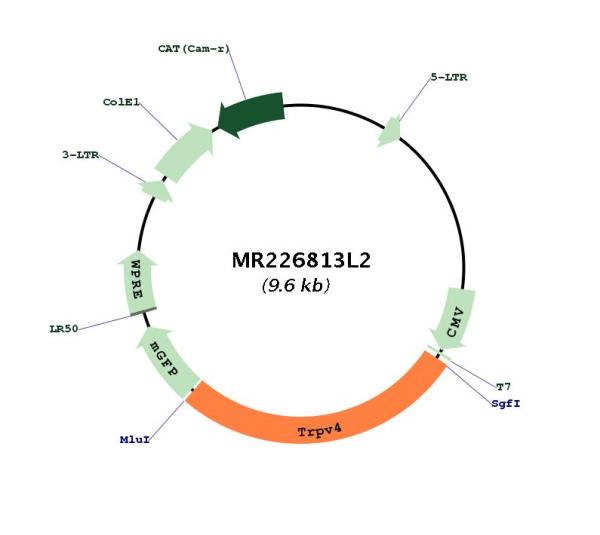Trpv4 (NM_022017) Mouse Tagged Lenti ORF Clone
CAT#: MR226813L2
- LentiORF®
Lenti ORF clone of Trpv4 (mGFP-tagged) - Mouse transient receptor potential cation channel, subfamily V, member 4 (Trpv4)
"NM_022017" in other vectors (6)
Interest in protein/lysate? Submit request here!
USD 365.00
Specifications
| Product Data | |
| Type | Mouse Tagged ORF Clone Lentiviral Particle |
| Tag | mGFP |
| Symbol | Trpv4 |
| Synonyms | 0610033B08Rik; OTRPC4; Trp12; VR-OAC; VRL-2; VROAC |
| Vector | pLenti-C-mGFP |
| E. coli Selection | Chloramphenicol (34 ug/mL) |
| Mammalian Cell Selection | None |
| Sequence Data |
The ORF insert of this clone is exactly the same as(MR226813).
|
| Restriction Sites |
SgfI-MluI
Cloning Scheme for this gene
Plasmid Map

|
| ACCN | NM_022017 |
| ORF Size | 2616 bp |
| OTI Disclaimer | Due to the inherent nature of this plasmid, standard methods to replicate additional amounts of DNA in E. coli are highly likely to result in mutations and/or rearrangements. Therefore, OriGene does not guarantee the capability to replicate this plasmid DNA. Additional amounts of DNA can be purchased from OriGene with batch-specific, full-sequence verification at a reduced cost. Please contact our customer care team at custsupport@origene.com or by calling 301.340.3188 option 3 for pricing and delivery. The molecular sequence of this clone aligns with the gene accession number as a point of reference only. However, individual transcript sequences of the same gene can differ through naturally occurring variations (e.g. polymorphisms), each with its own valid existence. This clone is substantially in agreement with the reference, but a complete review of all prevailing variants is recommended prior to use. More info |
| OTI Annotation | This clone was engineered to express the complete ORF with an expression tag. Expression varies depending on the nature of the gene. |
| Product Components | The ORF clone is ion-exchange column purified and shipped in a 2D barcoded Matrix tube containing 10ug of transfection-ready, dried plasmid DNA (reconstitute with 100 ul of water). |
| Reconstitution | 1. Centrifuge at 5,000xg for 5min. 2. Carefully open the tube and add 100ul of sterile water to dissolve the DNA. 3. Close the tube and incubate for 10 minutes at room temperature. 4. Briefly vortex the tube and then do a quick spin (less than 5000xg) to concentrate the liquid at the bottom. 5. Store the suspended plasmid at -20°C. The DNA is stable for at least one year from date of shipping when stored at -20°C. |
| Reference Data | |
| RefSeq | NM_022017.3, NP_071300.2 |
| RefSeq Size | 3247 bp |
| RefSeq ORF | 2616 bp |
| Locus ID | 63873 |
| UniProt ID | Q9EPK8 |
| Cytogenetics | 5 F |
| Gene Summary | Non-selective calcium permeant cation channel involved in osmotic sensitivity and mechanosensitivity (PubMed:11094154). Activation by exposure to hypotonicity within the physiological range exhibits an outward rectification (PubMed:12093812, PubMed:14691263, PubMed:16368742, PubMed:16571723). Also activated by heat, low pH, citrate and phorbol esters (PubMed:14691263). Increase of intracellular Ca(2+) potentiates currents. Channel activity seems to be regulated by a calmodulin-dependent mechanism with a negative feedback mechanism (By similarity). Acts as a regulator of intracellular Ca(2+) in synoviocytes (By similarity). Plays an obligatory role as a molecular component in the nonselective cation channel activation induced by 4-alpha-phorbol 12,13-didecanoate and hypotonic stimulation in synoviocytes and also regulates production of IL-8 (By similarity). Together with PKD2, forms mechano- and thermosensitive channels in cilium (PubMed:18695040). Promotes cell-cell junction formation in skin keratinocytes and plays an important role in the formation and/or maintenance of functional intercellular barriers (PubMed:20413591). Negatively regulates expression of PPARGC1A, UCP1, oxidative metabolism and respiration in adipocytes (PubMed:23021218). Regulates expression of chemokines and cytokines related to proinflammatory pathway in adipocytes (PubMed:23021218). Together with AQP5, controls regulatory volume decrease in salivary epithelial cells (PubMed:16571723). Required for normal development and maintenance of bone and cartilage (By similarity).[UniProtKB/Swiss-Prot Function] |
Documents
| Product Manuals |
| FAQs |
| SDS |
Resources
Other Versions
| SKU | Description | Size | Price |
|---|---|---|---|
| MC222327 | Trpv4 (untagged) - Mouse transient receptor potential cation channel, subfamily V, member 4 (Trpv4), (10ug) |
USD 1,197.00 |
|
| MG226813 | Trpv4 (tGFP-tagged) - Mouse transient receptor potential cation channel subfamily V member 4 (Trpv4), (10ug) |
USD 1,397.00 |
|
| MR226813 | Trpv4 (Myc-DDK-tagged) - Mouse transient receptor potential cation channel, subfamily V, member 4 (Trpv4) |
USD 1,197.00 |
|
| MR226813L1 | Lenti ORF clone of Trpv4 (Myc-DDK-tagged) - Mouse transient receptor potential cation channel, subfamily V, member 4 (Trpv4) |
USD 1,497.00 |
|
| MR226813L3 | Lenti ORF clone of Trpv4 (Myc-DDK-tagged) - Mouse transient receptor potential cation channel, subfamily V, member 4 (Trpv4) |
USD 1,497.00 |
|
| MR226813L4 | Lenti ORF clone of Trpv4 (mGFP-tagged) - Mouse transient receptor potential cation channel, subfamily V, member 4 (Trpv4) |
USD 1,497.00 |
{0} Product Review(s)
Be the first one to submit a review






























































































































































































































































 Germany
Germany
 Japan
Japan
 United Kingdom
United Kingdom
 China
China


